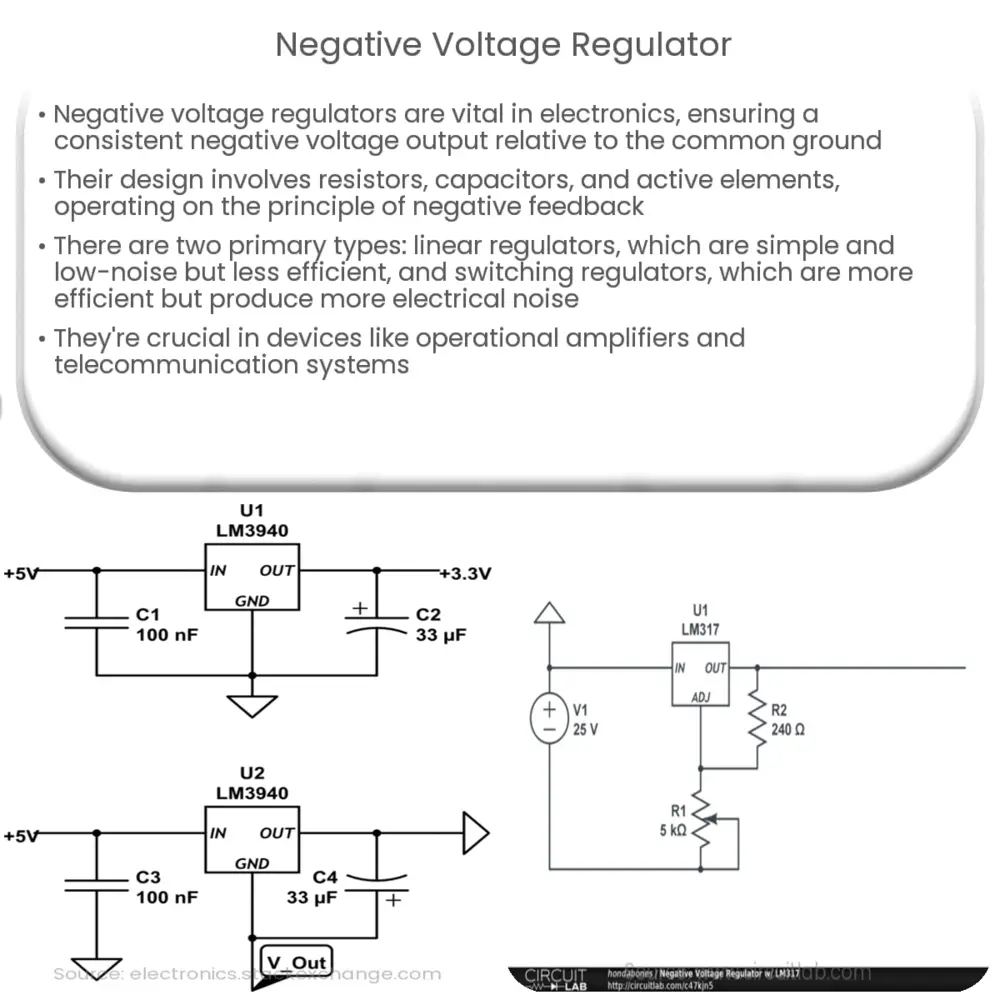Explore the world of negative voltage regulators, their design, applications, and impact in various electronic devices and systems.

Negative Voltage Regulators: Understanding and Applications
In the realm of electronics, one indispensable component is the voltage regulator. These devices are designed to automatically maintain a constant voltage level. They are integral to a vast array of electrical devices, ensuring the right amount of power is provided for safe and efficient operation. However, not all voltage regulators are created equal. In this article, we delve into the world of negative voltage regulators, their design, applications, and benefits.
What is a Negative Voltage Regulator?
A negative voltage regulator is a specific type of voltage regulator designed to output a negative voltage. While positive voltage regulators are more common and regulate voltage in the positive half of the electrical circuit, negative voltage regulators manage the negative side. They provide a constant output voltage that is negative relative to the common ground.
Design and Operation
Negative voltage regulators are made up of a combination of resistors, capacitors, and active elements like transistors or operational amplifiers. The active elements are crucial for maintaining the negative voltage output.
The operation of a negative voltage regulator is based on the principle of negative feedback. In this context, a portion of the output voltage is inverted and fed back to the input. When the output voltage rises above the desired level, this feedback signals the regulator to decrease the output. Conversely, when the output voltage drops below the desired level, the feedback signals an increase in output. This constant adjustment helps maintain a steady negative output voltage, despite variations in input voltage or load conditions.
Types of Negative Voltage Regulators
Just like their positive counterparts, negative voltage regulators also come in different types, primarily divided into two categories: linear and switching regulators.
- Linear Negative Voltage Regulators: These are the simplest and most common type of voltage regulators. They operate by dissipating excess power as heat to regulate the voltage. This makes them less efficient, especially at high input-output differential, but they offer the advantages of simplicity and low noise.
- Switching Negative Voltage Regulators: Unlike linear regulators, switching regulators operate by switching the input voltage on and off rapidly to achieve the desired output voltage. This operation makes them more efficient but at the cost of generating more electrical noise.
Each type of regulator has its specific applications, advantages, and drawbacks, which we’ll explore in the following sections.
Applications of Negative Voltage Regulators
Negative voltage regulators find their applications in a variety of electronic devices and systems. Here are a few notable examples:
- Operational Amplifiers: These are often used in operational amplifier circuits where a negative supply voltage is required. They help maintain the stability of the op-amp by providing a steady negative voltage.
- Power Supplies: In dual polarity power supplies, negative voltage regulators are used to provide a steady negative voltage, which is essential for powering certain electronic components and systems.
- Telecommunication Systems: Negative voltage regulators play a crucial role in telecommunication systems by providing the negative voltages necessary for certain transmission and receiving circuits.
Advantages and Drawbacks
Like any electronic component, negative voltage regulators come with their own set of benefits and drawbacks.
The main advantage of negative voltage regulators is their ability to provide a stable and constant negative voltage, which is essential for the functioning of many electronic devices. They are reliable, relatively inexpensive, and readily available, which makes them a popular choice in various applications.
However, they do have some downsides. For instance, linear negative voltage regulators, while being simple and producing low noise, are not as efficient as their switching counterparts. They can waste a significant amount of power as heat, especially when the difference between the input and output voltage is high. On the other hand, switching negative voltage regulators, while more efficient, can generate a significant amount of electrical noise, which can interfere with the operation of sensitive electronic devices.
Conclusion
In conclusion, negative voltage regulators are essential components in the world of electronics. They ensure the smooth and reliable operation of various devices and systems by maintaining a constant negative voltage. While they come with their own sets of advantages and disadvantages, understanding their operation and applications can help us make informed decisions when designing or working with electronic circuits. Regardless of their limitations, their role in powering the electronics we use daily is undeniably pivotal. As technology continues to evolve, we can expect to see even more advanced and efficient designs of these critical components.

